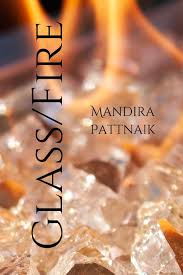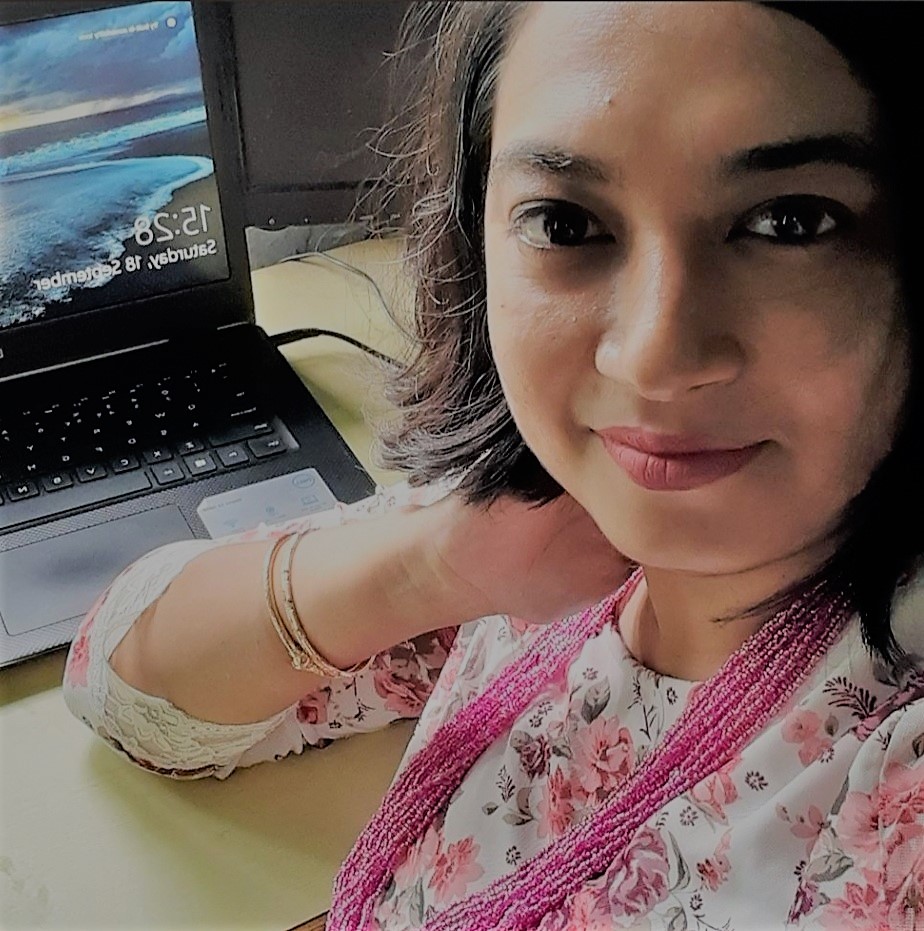Published June 13th, 2025
Interview
by Niki Radman
Mandira Pattnaik is an Indian writer whose work appears in The Rumpus, Emerson Review, Quarterly West, Best Small Fictions Anthology (2021 & 2024) and Best Microfiction Anthology (2024), among others. Her writing has been recognized by listing in Wigleaf Top 50 (2023), and longlisting in Commonwealth Short Story Prize (2025), among others. She serves on the mastheads of Best Small Fictions Anthology 2025, Iron Horse Literary Review, Vestal Review, and trampset. Her books include Girls Who Don't Cry (2023), Where We Set Our Easel (2023), the novella-in-flashGlass/Fire (2024, Querencia Press) and White Hot Moon (forthcoming). Her piece “un_broken” appeared in Tint Journal in 2023. With Tint’s contributor Niki Radman, Mandira spoke about her approach to writing Glass/Fire as well as some of her influences and upcoming work.
Niki Radman: First of all, thank you for writing this thought-provoking and beautiful text. To start us off, I wanted to ask you a question about form. I hadn’t come across the novella-in-flash format before — could you give me your definition of it?
Mandira Pattnaik: Thank you for saying this! Yes, it has only recently dawned on me how important form is to the telling of a story. Growing up in India, I hadn’t even heard of flash fiction, let alone novella-in-flash (NiF) fiction until I started writing for international magazines. Even to this day, you’ll hardly find any publications in India dedicated to flash fiction. Once I started writing regularly, I was totally enamored by the possibilities that the flash format offered, and heavily used it to express my narratives. Appreciating my passion for this category, Jude Higgins, who runs the Bath Flash Fiction Award and directs short fiction press Ad Hoc Fiction UK, sent me a free copy of How To Make A Window Snake: Three Novellas in Flash Fiction, all the way to India. In this book, there are three novellas-in-flash written by three different authors, one of them being Charmaine Wilkerson (who subsequently wrote the book Black Cake: A Novel that made President Obama’s Summer Reading List). Immediately hooked, I tried my hand at the NiF format, tasting success with my first novella-in-flash titled Where We Set Our Easel, which was acquired by the first publisher the manuscript was sent to in 2022. Glass/Fire is my second NiF, but I consider myself still new to the format, still trying to find my bearings. My definition of “novella-in-flash” would be a novel told in fragmented stories, each less than 1000 words.
Niki: What made you choose the novella-in-flash for this story?
Mandira: Some stories of Glass/Fire had been written and published even before my first novella. The way I envisaged the complete arc of the story, it was clear that a sense of omnipresent brokenness punctures the picture-perfect world the three main characters (the narrator, her sister Lily and the girl Jo) of Glass/Fire wish-dreamed for themselves.

I think the story deviated every time the narrative wanted to take a planned course, leading to more fragmentation. Some threads lead to worse outcomes, even ruination. I think the novella-in-flash form totally surrenders to this bits-and-pieces vision of brokenness, an allusion to fragmentation, like a glass piece shattered. In structuring the novella, it organically followed that there is a cadence of construction and deconstruction. Ultimately though, Glass/Fire is a full arc of a novel, fitted into a concise, miniature world that is told as though shards of something shattered are rejoined into the whole.
Niki: Can you tell me about the reasons you chose to write this story in English, as opposed to another language? When do you find yourself writing fiction/poetry in languages other than English?
Mandira: Curious as it may seem, I have had an interesting relationship with languages. My mother tongue is Bangla — I speak the language with family but never in school, and I have read Bangla novels and books widely. I studied Hindi in school as a language and love to read in Hindi too. My school’s medium of instruction was English, but my parents, like most parents of formerly colonized nations, had provided me with English classics and other children’s books in English at a very young age. I began to love English more than the other languages growing up, even unknowingly beginning to creatively write in it when I was in junior school, eventually becoming the editor of my school magazine. I have never written in any other language other than English.
Niki: I was really struck by how your text repeatedly describes the textures and properties of certain natural elements and materials, by how it evokes material flexibility, breakability, resistance, or reconfiguration. I would love to hear more about how non-human things and processes became such a significant part of Glass/Fire.
Mandira: Somehow, for me, I have always been fascinated by the origins of stuff that I see and their aftermath. In fact, to extend this line of thinking, I might be treading into imagining these “non-human things,” natural objects and nature itself, as having an “existence” of their own. Naturally, they have a life-arc to navigate so to say, and therefore the “flexibility,” “breakability” and “reconfigurations” in similar fashion as we humans do. Instead of examining this philosophically, which is more intentional, I wanted to explore this scientifically. Thus, processes and process loss form part of the narrative. I greedily borrow from science and make it work against the artful and lyrical aspects of the plot, which results in a constant osmosis and interaction. I love that science has come so much into discussion in the context of this novella, and we are becoming more familiar to this experiment.

Niki: “Lambda” is a chapter I found especially beautiful. It might be my favourite. Is there a chapter or a segment of Glass/Fire that is particularly meaningful or beautiful to you?
Mandira: I am so glad “Lambda” is your favorite chapter. “Lambda” first appeared in New Flash Fiction Review (NFFR) in February 2021 as a micro essay. Interestingly, the then editor of NFFR was Charmaine Wilkerson, whom I mentioned just before. Charmaine especially solicited my work and asked for a nonfiction piece even though I had already been publishing a lot of flash fiction by that time. The piece is based on my memories of my grandfather who passed away at the age of ninety. I was only ten then, but certain aspects of his character have deeply influenced me. So “Lambda” is definitely one of the more meaningful chapters in this novella. I also closely identify with forced displacement and uprootedness as social phenomena, so the early chapters feel personal. For example, the story “Close as Breath” compares and contrasts two very diverse lives — the life that the girls, Lily and the narrator, were used to abroad, and the one they were now expected to lead back in India. It says a lot about the crisis of identity in the face of uprootedness. In a very different context, “Half-kissed Girlfriend” and “Prosody of Rains” are meaningful. In India, we have these flying accidents ever so often, where young trainee pilots die when their faulty, archaic, good-to-be-scrapped aircrafts crash for no fault of theirs. Deeply disturbing as it is, I think of their mothers and wives, how it must feel to them. Ultimately, it surprises me how things that were only small and cooped-up in the recesses of one’s mind keep building-up as one writes them down, and then show up as full-fledged stories that record factual happenings and provoke others.
Niki: Would you like to shout out any storytellers you admire or who have influenced your writing?
Mandira: I love reading Arundhati Roy, Amitav Ghosh and Anita Desai. For someone in India, you can imagine, it is not easy to get hold of recently published books. We do not have many libraries and import costs are prohibitive. I read the classics as every good Indian student does, and still sometimes reread them. I never stick to one book or genre, reading as widely as possible, from literary to speculative, to biographies and history books, to nature journals and comics. I loved the experimentation with a second-person narrator in The Seven Moons of Maali Almeida by Shehan Karunatilaka, the Booker Prize winner. If you want me to name one writer whom I consider to have influenced my writing, that has to be James Joyce. Among fellow contemporary writers, I make sure to read Frances Ogamba and Lucy Zhang whenever they publish something.
Niki: Lastly, what are you working on at the moment?
Mandira: When someone asks me this, I am, kind of, in shock. What exactly am I working on, and am I really working on something? I know that sounds funny, but I do get uninterested easily. To avoid some of that feeling, I keep myself busy with multiple projects: I am charting out a nonfiction book about growing up in India. I am also halfway through a speculative fiction novella that I am really excited about. My fiction novel (multiple PoV, experimental format, part historical fiction) is past its drafting stage but badly needs revisions, which I undertake off-and-on. A book of collected short stories is on submission and I hope it marks a new beginning. Finally, I have a hybrid poetry and prose chapbook titled White Hot Moon forthcoming in Fall 2025 via Red Bird Chapbooks, and I will shortly begin working on its finalization.
Nationality: Austrian
First Language(s): German
Second Language(s):
English
Supported by:

